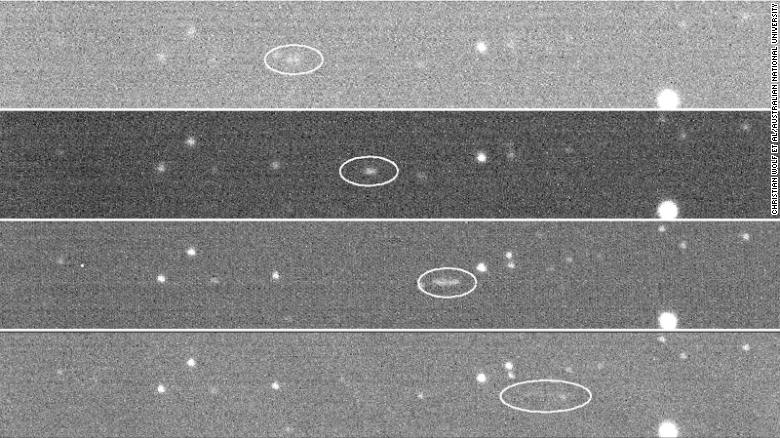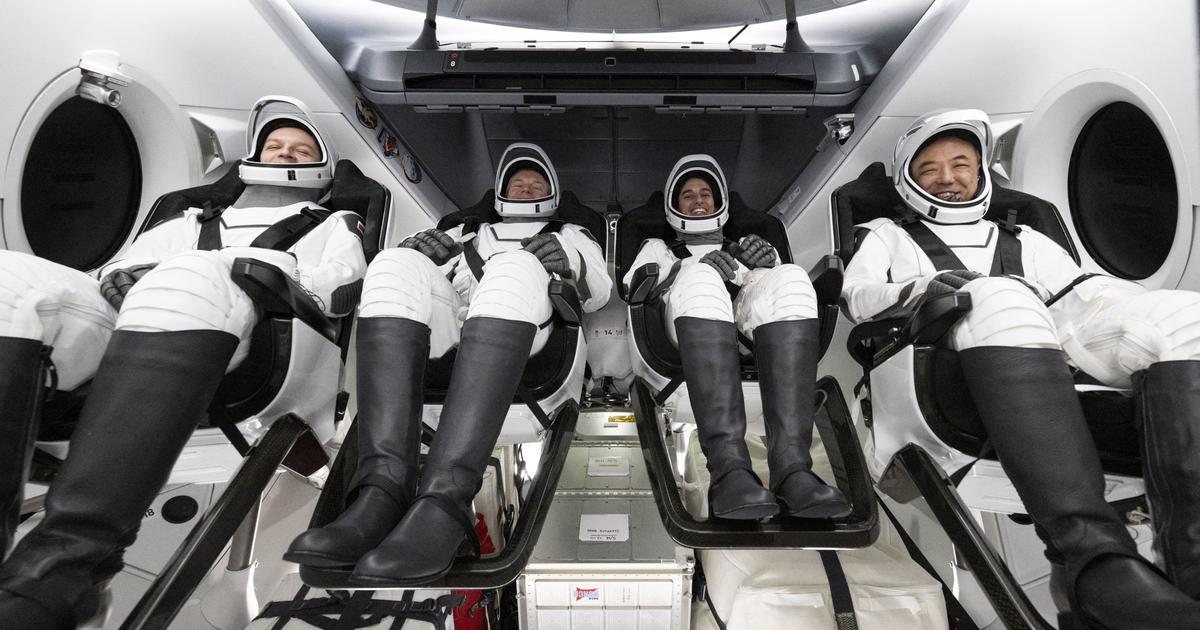This fragment of asteroid 2018 LA was recovered in the Central Kalahari Game Reserve in central Botswana.
(CNN) -
For the first time, scientists have been able to accurately map the flight path of an asteroid that landed on Earth and trace it back to its point of origin.
The rock-sized fragment's journey to our planet began 22 million years ago, according to new research.
The asteroid, known as 2018 LA, appeared as a fireball in the skies over Botswana on June 2, 2018, before breaking apart and landing in the Central Kalahari Game Reserve.
Before breaking up in Earth's atmosphere, scientists determined that the asteroid was about 1.7 meters in diameter, weighed 5,699 kilograms, and had been traveling at about 60,000 kilometers per hour.
"When the asteroid disintegrated 27 km from Earth, it was 20,000 times brighter than the full Moon," said Christian Wolf, a co-author of the study and associate professor at the Australian National University Research School of Astronomy and Astrophysics. (ANU), in a statement.
The study was published last week in the journal Meteoritics and Planetary Science.
The researchers were able to locate the fragments, called meteorites, and study them.
Their findings provide new insights into the history of our solar system.
advertising
Tracking an asteroid
On June 2, 2018, the asteroid was discovered to have an impact trajectory with Earth and, eight hours after being detected, it appeared over South Africa with a flash.
The asteroid was first sighted by the University of Arizona's Catalina Sky Survey, appearing as a faint point of light buzzing between the stars.
This astronomical study is part of NASA's Planetary Defense program and looks for asteroids approaching Earth.
"Small asteroids the size of one meter are not a danger to us, but they hone our abilities to detect approaching asteroids," said Eric Christensen, co-author of the study and director of the Catalina Sky Survey program, in a statement.
Peter Brown, professor and chair of small planetary body research at Western University in Ontario, worked with the Western Meteor Group to analyze the sound waves from the fireball as it passed through Earth's atmosphere.
The asteroid had one-thirtieth of the energy of the atomic bomb dropped on Hiroshima during World War II.
"The infrasonic shock wave measured in South Africa was not as strong as expected from detections of bright light by US government sensors," Brown said in a statement.
Data from the Catalina Sky Survey, as well as the ANU SkyMapper telescope in New South Wales, made it possible to trace the asteroid's journey towards Earth.
This is the second time scientists have been able to observe an asteroid in space before it hits Earth.
The first was asteroid 2008 TC3 in Sudan 10 years ago, according to Peter Jenniskens, lead author of the study and meteorite astronomer at the SETI Institute and NASA's Ames Research Center.
The SkyMapper project was able to capture the asteroid in action.
"I couldn't believe my eyes when I came across a small object that seemed to move through the images taken by SkyMapper," said Christopher Onken, co-author of the study and scientist and astronomer on the ANU SkyMapper project, in a statement. .
These last images before the asteroid entered Earth's atmosphere were SkyMapper's biggest contribution.
They helped pinpoint both the search area for the meteorite fragments on Earth and the origin of the meteorite in space. '
Meteorites among the fauna
Data from the multiple astronomical observations, along with recorded videos of the fireball, helped the researchers determine that the meteorites had landed in the Central Kalahari Game Reserve, where wild animals such as leopards and lions live.
The Botswana Department of Wildlife and National Parks and the country's Department of Museums and National Monuments helped the researchers search and stay safe in their search for the fragments.
On the last day of searching, Lesedi Seitshiro of the Botswana International University of Science and Technology found the first one.
It weighed 18 grams and measured only 3 centimeters.
This fragment of asteroid 2018 LA was recovered in the Central Kalahari Game Reserve in central Botswana.
"The meteorite is named 'Motopi Pan' in honor of a local watering hole," said Mohutsiwa Gabadirwe, a co-author of the study and a geoscientist at the Botswana Institute of Geosciences, in a statement.
"This meteorite is a Botswana national treasure."
Gabadirwe is now the curator of the Motopi Pan meteorite.
The researchers discovered a total of 23 fragments within a few months of the event.
Finding your home
The asteroid's trajectory was traced to Vesta, the second largest asteroid in our solar system.
It is "the only one bright enough to be visible to the naked eye sometimes," Onken said.
According to the researchers, Vesta's Veneneia basin was created by an impact, and asteroid 2018LA is a chunk of Vesta that rushed into space when this impact occurred.
NASA's Dawn spacecraft studied the giant asteroid Vesta from July 2011 to September 2012.
Motopi Pan belongs to a group of Howardite-Eucrite-Diogenite meteorites, named for their composition, that come from Vesta.
This asteroid is located in the inner part of the asteroid belt between Mars and Jupiter.
Some of the oldest known materials from Vesta and meteorites include zirconium mineral grains that date back more than 4.5 billion years, that is, from the birth of our solar system.
"Combining observations of the small asteroid in space with information from meteorites shows that it likely came from Vesta, the second largest asteroid in our solar system and target of NASA's DAWN mission," said Jenniskens.
'Billions of years ago, two giant impacts on Vesta created a larger and more dangerous family of asteroids.
The recently recovered meteorites have given us a clue as to when these impacts could have occurred. '
Analysis of the meteorite revealed that it was buried under the surface of Vesta.
This also helped the researchers find that the Veneneia Basin was probably formed around 4.2 billion years ago.
Another expedition in 2020 revealed another Motopi Pan meteorite, which is the largest fragment to date, weighing 92 grams.
Researchers are eager to see if it contributes to Vesta's story.
NASA's Ingenuity Helicopter Makes Successful First Flight on Mars
It is difficult to understand the connections between the meteorite fragments and the asteroids from which they came.
Although scientists know the location and current size of about 1 million asteroids, they do not know their composition.
On the other hand, they know what meteorites are made of, but they don't know where most of them came from before they hit Earth.
These are the new images of the asteroid Bennu 0:35
“That is, in essence, what we are trying to solve: matching the types of meteorites with the types of asteroids.
Tracing all the way to a probable crater is a bit like looking for clues to a murder that occurred 22 million years ago and trying to understand what happened, ”said Hadrien Devillepoix, study co-author and astronomer at Curtin University in Australia. .
'Every time we recover a fresh meteorite with an associated orbit, we slowly map the composition of the asteroid belt.
The more we get, the better this map will be.
Meteorite NASA






/cloudfront-eu-central-1.images.arcpublishing.com/prisa/XY3C6N54G4B3XBPGV7YLE3AUKM.jpg)

